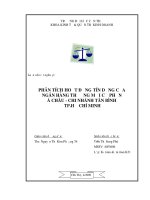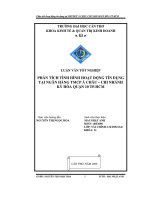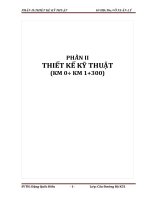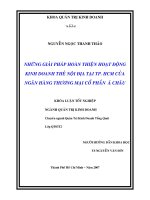Wood is good: A way forward for climate change mitigation - Trường Đại học Công nghiệp Thực phẩm Tp. Hồ Chí Minh
Bạn đang xem bản rút gọn của tài liệu. Xem và tải ngay bản đầy đủ của tài liệu tại đây (361.49 KB, 6 trang )
<span class='text_page_counter'>(1)</span><div class='page_container' data-page=1>
<i><b>Int.J.Curr.Microbiol.App.Sci </b></i><b>(2017)</b><i><b> 6</b></i><b>(11): 5460-5465 </b>
5460
<b>Review Article</b>
<b>Wood is Good: A Way Forward for Climate Change Mitigation </b>
<b>Arvind Bijalwan1*, Anil Kumar Shankhwar1, Manmohan J. R. Dobriyal2 </b>
<b>and Pooja Verma1</b>
1
Indian Institute of Forest Management, P.O. Box- 357, Nehru Nagar,
Bhopal-462003, M.P., India
2
Department of Silviculture and Agroforestry, College of Forestry, Navsari Agricultural
University, Navsari- 396450, Gujarat, India
<i>*Corresponding author </i>
<i><b> </b></i> <i><b> </b></i><b>A B S T R A C T </b>
<i><b> </b></i>
<b>Introduction </b>
Utility and durability of wood made it an
asset either cradle or coffin which is
conventionally tested by graveyard test. The
ancient Madhuca wood pillar of Sarnath and
magnificent wooden doors of different
palaces, Buddhist wooden pagodas, temples
and other ancient religious buildings in India
and wooden bridge of Myanmar etc. are few
live examples to exemplified potential of
locked carbon in wood. It offers a number of
environmental benefits over other building
material with less energy to produce and
stores carbon. It owns the quality to be
renewable, reusable, recyclable, durable and
flexible. In last 50 year forests have absorbed
about 30% of annual global anthropogenic
CO2 emissions. It produces wood as an option
for fossil fuels and carbon-intensive
high-energy materials such as concrete and steel
(Borjsson and Gustavsson, 2000). In nutshell,
for the sake of environmental concern, the
<i>wood is good</i> as it is long-lasting retainer of
carbon. The role of forest can be understood
with the fact that the annual incremental
carbon accumulation in India’s forest
estimated as 59.2 Mt which means an annual
removal of 217.07 Mt CO2 equivalents, thus
the forests of India are playing a significant
Wood is an important asset since time immemorial, nowadays there is scarcity of
wood due to enormous population pressure and stringent law and regulations
against felling of tree in India. Tree conservation is associated with
multi-dimensional benefits but after attaining a physiological age (age of maturity) by
the tree it starts natural decaying if the wood is not utilized properly in time. It is
exiting fact that the natural decomposition of wood improves the fertility status
and physical properties of soil but at the same time the increasing demand of wood
need to be fulfilled. The demands of sustainable development rely on judicious use
of resource like wood for mankind. This paper elucidates the significance of tree
harvesting at maturity for better management of the forest resources over the
natural death of tree provided the wood is used in such a way that carbon can be
blocked in it for longer duration.
<b>K e y w o r d s </b>
Wood is good,
Carbon,
Decomposition,
Wood Harvesting
<i><b>Accepted: </b></i>
31 September 2017
<i><b>Available Online:</b></i>
10 November 2017
<b>Article Info </b>
<i>International Journal of Current Microbiology and Applied Sciences </i>
</div>
<span class='text_page_counter'>(2)</span><div class='page_container' data-page=2>
<i><b>Int.J.Curr.Microbiol.App.Sci </b></i><b>(2017)</b><i><b> 6</b></i><b>(11): 5460-5465 </b>
5461
role in capturing of substantial amount of
atmospheric CO2 which is the major reason of
global warming (IPCC, 2007). The growing
stock of Indian forest is estimated to be 5768
million cubic meter comprising 4195 million
cubic meter inside forest area and 1573
million cubic meter outside recorded forest
area (TOF) (ISFR, 2011).
If we talk about India, the reserve forest,
basically include those areas where
harvesting, felling and any operation is
strictly prohibited, this mostly includes the
national parks, sanctuaries and biosphere
reserve areas etc. In fact, trees are the sink
(Pan <i>et al.,</i> 2011) and source (Uri <i>et al.,</i> 2017)
of carbon, sink because trees capture the
carbon when it is live and source because tree
releases the carbon when it dies or after its
natural death or destructive utilization for fuel
wood, charcoal, biomass energy etc. The leaf
litter from the tree is added the organic carbon
to the soil which is helpful to the soil if in
desirable C/N ration only (Monika <i>et al.,</i>
2017). Beyond the required C/N ratio addition
the material to soil is not beneficial for soil
fertility and productivity of soil as the system
is input intensive (Jeet <i>et al.,</i> 2014). The
regeneration, maturation and death of old tree
are a common phenomenon in any of the
natural forest. However, the trees which have
completed its biological age, dead, standing
dead, decay and degenerating are the source
of carbon need to be handled in and processed
in proper way rather lying as such in the
forest and liberating the carbon to pollute the
environment. The astounding capacity of
wood to offset carbon emissions and natural
properties, wood is the most promising
material of the future with low carbon
footprint and economic carbon disposal
provided wood use should be responsibly
sourced and genuine certified. The demand of
wood like natural resource increased
exponentially (Shankhwar and Srivastava,
2015), human interference and inadequate
management results (Ingole <i>et al.,</i> 2015)
resource scarcity ultimately leads to hindrance
in sustainable development (Shankhwar <i>et al.,</i>
2015). The current demand of wood is mainly
substituted by the plastics, high energy
substances like cement, concrete and steel etc.
that drive the world towards the
unsustainability. Moreover, the land
availability for forest is also lacking factor for
regeneration and perpetuation of trees. So it is
better to harvest the tree at the biological
maturity for carbon sequestration, resource
utilization <i>e.g.</i> building construction,
furniture, and other valuable products
mentioned in Figure 1. These products are the
most suitable option for blocking of the
carbon for long term storage and ecological
benefits as well.
Forest also acts as source of carbon because
when forests release more carbon compared
to storage they act as a net carbon source and
eventually lead to rise in CO2 added to the
atmosphere. The world-wide forest depository
(ISFR, 2015) found to be more than 650
billion tonnes of carbon consisting of 44% as
biomass, 11% in dead wood and litter, and
45% in the soil. When an old tree fells downs
(dead wood) and decays, these trees emit
more carbon than they store. Hence, they
serve as a net carbon source after getting the
maximum exploitable volume and ultimately
convert towards source through an increase in
CO2 and other gases in the atmosphere during
</div>
<span class='text_page_counter'>(3)</span><div class='page_container' data-page=3>
<i><b>Int.J.Curr.Microbiol.App.Sci </b></i><b>(2017)</b><i><b> 6</b></i><b>(11): 5460-5465 </b>
5462
carbon sequestration in forest environments
(Russell <i>et al.,</i> 2015). During decomposition
of organism major chunk get back to
environment (Zeng, 2008). Hence, trees can
be considered as only temporarily carbon
sequesters and that by the time they start to
rot they adds carbon back to the environment.
In the present assessment total carbon in
Indian forest is estimated to be 7044 million
tonnes. There is an increase of 103 million
tonnes (1.48%) in the carbon stock of country
as compared to the last assessment in 2013
(ISFR, 2015). The responsible use of wood is
capable to fostering sustainable forest
management and panacea for a number of
organizations already working for the
promotion of wood and proclaimed its
benefits. As one of the premier places on
earth to grow trees and produce wood,
Oregon has an unparalleled opportunity to
support and advance the responsible use of
wood (OFRI, 2011). A study (Wihersaari,
2005), recommends that it’s better to use
comminuted forest residue before decay, if
possible within one week. Moreover, it’s
good to lock the wood carbon by building
wood products instead of left it for
decomposing. Some research (Borjesson and
Gustavsson, 2000) found net CO2 emission to
be lower for wood-framed buildings than for
concrete buildings, when considering forest
and sawmill residues as well as demolition
waste as substitutes for fossil fuel. The fact is
that Indian forest act 1927 has classified
forest to different categories <i>viz.</i> Reserve
forest, protected forest, un-classed forest and
Village Forest (Civil swayam forest) on the
basis of degree of protection and regulation of
management activities. Natural forests are
solely depending for restocking on natural
regeneration especially in Reserve Forest
(RF) and Protected Forest (PF) and in some
cases they have assisted natural regeneration.
There are series of silvicultural practices used
to manage these forests but due to present
conservation centric mindset, these
silvicultural practices became redundant.
</div>
<span class='text_page_counter'>(4)</span><div class='page_container' data-page=4>
<i><b>Int.J.Curr.Microbiol.App.Sci </b></i><b>(2017)</b><i><b> 6</b></i><b>(11): 5460-5465 </b>
5463
Sustainable forest management strategy has
goal to perpetuate the stabilized carbon stocks
for lengthier duration while producing forest
products like timber, fiber or energy etc. for
creating the mitigation advantage sustainably
at maximum (IPCC, 2007). We are looking
forward to cutting-edge strategy or revision of
existing strategies in such a way that enable to
sequester the carbon as much as its emission.
This revolutionary strategy may be framed for
carbon sequestration through the wood
conversion to high-utility resources like
wood-based sculpture, house architecture,
furniture and other products. It is important
that the carbon present in wood needs to be
blocked and retains into wood itself for
long-lasting period so that the wood-carbon may
not release in the atmosphere. It would be
desirably help to reduce the atmosphere CO2
by inflow of excess CO2 and other harmful
gases, this phenomenon is kept under the tag
line of <i>“Wood is Good”.</i> That means if we
use wood instead of it substitute like plastic,
iron and other metals etc, the more carbon can
be blocked for a period till it is completely
degenerated. Scientist (Pingoud and Perala,
2000) estimated the maximum wood
substitution potential in new building
construction in Finland.
It is a hard task to achieve the increment in
carbon storage or sequestration in to the forest
afterward attaining the maximum exploitable
volume of tree. Today in the age of
urbanization with declined per capita forest
area (FAO, 2009) wood is a promising tool to
mitigate the climate change discrepancies.
This conversion should be subjected to the
sustainable harvesting of forest produce;
other-wise it will induce further problems. As
it is an existing fact that if we harvest the
trees, there will be a negative impact on the
earth and environment. Large scale
deforestation is an important factor in global
climate change and other conjugated
problems (Jiao <i>et al.,</i> 2017). Wood is among
the top sustainable building materials in Japan
with 80% commercial use for building
construction unlike India non-existent of
wood in buildings in urban area, as the almost
100% of natural forests as protected. In India
wood used unsustainably as fuel-wood instead
of building industry (Sriprakash, 2017). In
addition to this, wooden buildings enable the
resistance against the seismicity coupled with
other environmental benefits like low carbon
emission during construction and effective in
energy conservation as well as CO2 reduction
(Naohito, 2011).
<b>Acknowledgement </b>
The authors are thankful to the Director,
Indian Institute of Forest Management,
Bhopal, India for his support and
encouragement while writing this article. The
authors are also grateful to the previous
workers whose work cited in this paper.
<b>References </b>
Bellassen, V. and Luyssaert, S., 2014.
Managing forests in uncertain times.
<i>Nature</i>, 504: 153-155.
Borjesson, P., Gustavsson, L., 2000.
Greenhouse gas balances in building
construction: wood versus concrete
from lifecycle and forest land-use
perspectives. <i>Energy Policy</i>, 28(9),
575-588.
Brown, S. L., and Schroeder, P. E., 1999.
Spatial patterns of aboveground
production and mortality of woody
biomass for eastern US forests. <i>Ecol </i>
<i>Appl.</i>, 9(3), 968-980.
</div>
<span class='text_page_counter'>(5)</span><div class='page_container' data-page=5>
<i><b>Int.J.Curr.Microbiol.App.Sci </b></i><b>(2017)</b><i><b> 6</b></i><b>(11): 5460-5465 </b>
5464
FAO, 2010. Global Forest Resources
Assessment Report. Food and
Agriculture Organization of the United
Nations, Rome.
Ingole, N.A., Ram, R.N., Ranjan, R. and
Shankhwar, A.K. 2015. Advance
application of geospatial technology for
fisheries perspective in <i>Tarai</i> region of
Himalayan state of Uttarakhand.
<i>Sustainable </i> <i>Water </i> <i>Resources </i>
<i>Management,</i> 1(2): 181-187.
Springer-Verlag, Berlin.
IPCC, 2007. Intergovernmental Panel on
Climate Change, Fourth Assessment
Report, 2007
ISFR, 2011. India State of Forest Report,
Forest Survey of India, Dehradun, Govt.
of India.
ISFR, 2015. India State of Forest Report,
Forest Survey of India, Dehradun, Govt.
of India.
Jeet, I., Pandey, P.C., Singh, G.D. and
Shankhwar, A.K. (2014). Influence of
organic and inorganic sources of
nutrients on growth and yield of rice in
<i>Tarai</i> region of Uttarakhand. <i>Ann. </i>
<i>Agric. Res</i>. New Series. 35 (2):
176-182.
Jiao, T., Williams, C. A., Ghimire, B., Masek,
J., Gao, F., and Schaaf, C.,2017. Global
climate forcing from albedo change
caused by large-scale deforestation and
reforestation: quantification and
attribution of geographic variation.
<i>Climatic Change</i>, 142(3-4), 463-476.
Kueppers, L. M., Southon, J., Baer, P., and
Harte, J., 2004. Dead wood biomass and
turnover time, measured by
radiocarbon, along a subalpine elevation
gradient. <i>Oecologia</i>, 141(4), 641-651.
Monika, Shankhwar, A.K., Tamta, P., Singh,
V. and Prasad, R. 2017. Litter
decomposition dynamics in Foothills
Agroforestry System of Indian
Himalayan Shivalik Range. <i>Indian </i>
<i>Journal of Agroforestry,</i> 19(1): 75-78.
Naohito, K. 2011. Just how good is wood.
/>ts/topics/japan-journal/pdf/jj2011 aug_
19-21.pdf
OFRI, 2011. Environmental Benefits of Wood
Products. Oregon Forest Resources
Institute. 2011. 317 SW Sixth Ave.,
Suite 400, Portland, Oregon 97204
Pan, Y., Birdsey, R. A., Fang, J., Houghton,
R., Kauppi, P. E., Kurz, W. A., Phillips,
O.L., Shvidenko, A., Lewis, S.L.,
Canadell, J.G. and Ciais, P. 2011. A
large and persistent carbon sink in the
world’s forests. <i>Science</i>, <i>333</i>(6045),
988-993.
Pingoud, K., Perala, A. L. 2000. Studies on
greenhouse impacts of wood
construction. 1. Scenario analysis of
potential wood utilisation in Finnish
new construction in 1990 and 1994. 2.
Inventory of carbon stock of wood
products in the Finnish building stock in
1980, 1990 and 1995. Publication 840,
Technical Research Centre of Finland,
VTT Julkaisuja, Espoo. (in Finnish,
abstract in English) Web accessible at
/>J840.pdf
Russell, M. B., Fraver, S., Aakala, T., Gove,
J. H., Woodall, C. W., D’Amato, A. W.,
and Ducey, M. J. 2015. Quantifying
carbon stores and decomposition in
dead wood: A review. <i>For. Ecol. </i>
<i>Manage</i>., 350, 107-128.
Shankhwar, A.K. and Srivastava, R.K. 2015.
Biomass production through grey water
fertigation in <i>Eucalyptus hybrid</i> and its
economic significance. <i>Environ. Prog. </i>
<i>Sustainable Energy.</i> 34(1): 222-226.
Shankhwar, A.K., Ramola, S., Mishra, T. and
Srivastava, R.K. 2015. Grey water
pollutant loads in residential colony and
its economic management. <i>Renewables</i>:
<i>Wind, </i> <i>Water, and </i> <i>Solar.</i> 2(1):5.
Springer-Verlag, Berlin.
</div>
<span class='text_page_counter'>(6)</span><div class='page_container' data-page=6>
<i><b>Int.J.Curr.Microbiol.App.Sci </b></i><b>(2017)</b><i><b> 6</b></i><b>(11): 5460-5465 </b>
5465
different building?
indianexpress.com/opinions/2017/apr/2
9/wood-you-like-to-have-a-different-building-1598878.html
Uri, V., Kukumägi, M., Aosaar, J., Varik, M.,
Becker, H., Morozov, G., and Karoles,
K. 2017. Ecosystems carbon budgets of
differently aged downy birch stands
growing on well-drained
peatlands. <i>Forest </i> <i>Ecology </i> <i>and </i>
<i>Management</i>, 399, 82-93.
Wihersaari, M., 2005. Evaluation of
greenhouse gas emission risks from
storage of wood residue. <i>Biomass </i>
<i>Bioenergy</i>, 28(5), 444-453.
Zeng, N., 2008. Carbon sequestration via
wood burial. <i>Carbon Balance and </i>
<i>Management</i>, 3(1), 1.
<b>How to cite this article: </b>
Arvind Bijalwan, Anil Kumar Shankhwar, Manmohan J.R. Dobriyal and Pooja Verma. 2017.
Wood is Good: A Way Forward for Climate Change Mitigation. <i>Int.J.Curr.Microbiol.App.Sci.</i>
</div>
<!--links-->




![Tin học đại cương giáo trình dùng cho khối a đỗ thị mơ…[và những người khác] đại học nông nghiệp hà nội, 2006](https://media.store123doc.com/images/document/14/y/tv/medium_TOzmI9pifd.jpg)




